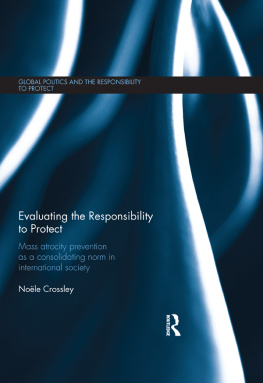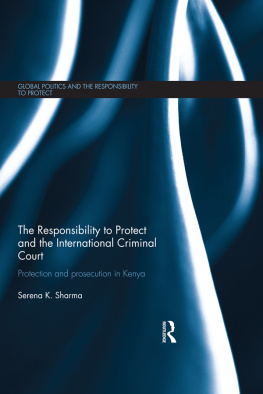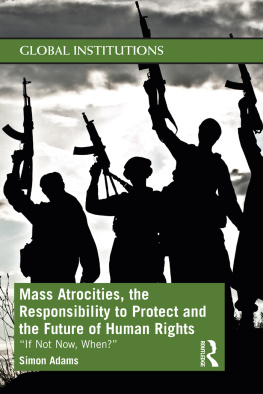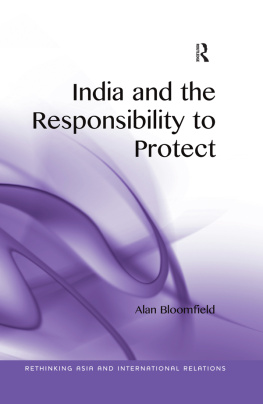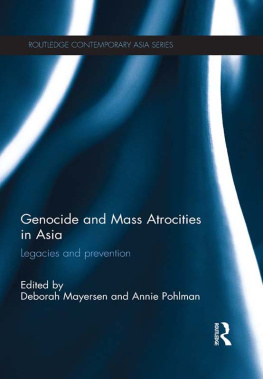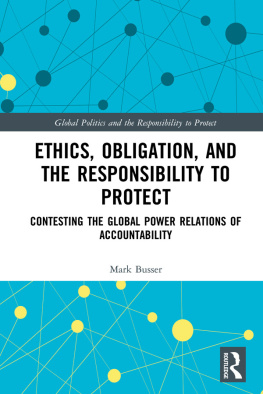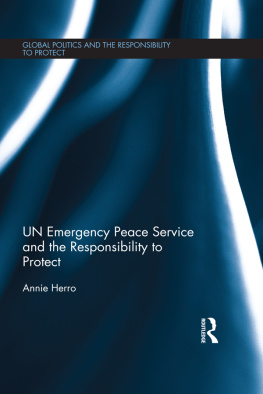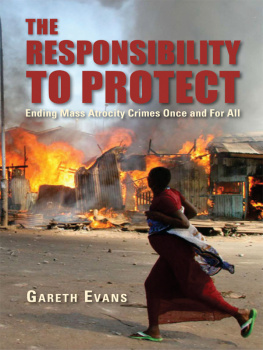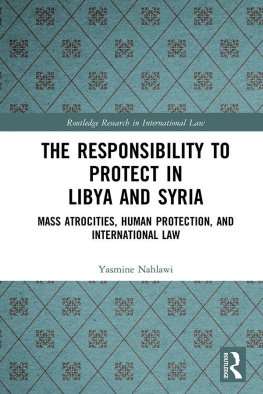Evaluating the Responsibility to Protect
This book evaluates the extent to which the Responsibility to Protect (R2P) has consolidated as a norm in international society.
A consolidated norm in international society is defined here as a regularised pattern of behaviour that is widely accepted as appropriate within a given social context. The analysis is based on the assumption that R2P could be regarded as a consolidated norm if it were applied consistently when genocide and other mass atrocities occur; and if international responses routinely conformed to the core principles inherent in R2P: seeking government consent, multilateralism, prevention and regionalism. This book employs Finnemore and Sikkinks norm life cycle model to determine the putative norms degree of consolidation, with in-depth case studies of the international responses to crises in Darfur and Kenya serving to illuminate the findings. It advances the argument that, whilst R2P had fully emerged as a prospective norm by 2005, it has not yet fully consolidated as an international norm. R2P has been remarkably successful at pervading the international discourse but has been somewhat less successful at consistency in implementation in terms of adherence to its core principles as outlined above (the qualitative dimension of R2P). Furthermore, it has been least successful, to date, in terms of consistency across cases in terms of resolve and tenacity. The volume concludes with a reflection on the norms progress so far, and its prospects for further consolidation, assuming R2P continues on its current trajectory.
This book will be of much interest to students of the Responsibility to Protect, humanitarian intervention, international law, security studies and IR.
Nole Crossley holds a PhD in International Relations from the London School of Economics and Political Science (LSE), UK.
Global Politics and the Responsibility to Protect
Series Editors:
Alex J. Bellamy
Griffith University
Sara E. Davies
Griffith University
and
Mnica Serrano
The City University of New York
The aim of this book series is to gather the best new thinking about the Responsibility to Protect into a core set of volumes that provides a definitive account of the principle, its implementation, and its role in crises, that reflects a plurality of views and regional perspectives.
The Responsibility to Protect
Norms, laws and international politics
Ramesh Thakur
Humanitarian Intervention and the Responsibility to Protect
Security and human rights
Cristina G. Badescu
Sri Lanka and the Responsibility to Protect
Politics, ethnicity, genocide
Damien Kingsbury
International Responsibility and Grave Humanitarian Crises
Collective provision for human security
Hannes Peltonen
Global Justice, Kant and the Responsibility to Protect
A provisional duty
Heather M. Roff
UN Emergency Peace Service and the Responsibility to Protect
Annie Herro
International Organizations and the Implementation of the Responsibility to Protect
The humanitarian crisis in Syria
Edited by Daniel Silander and Don Wallace
Moral Responsibility, Statecraft, and Humanitarian Intervention
The US response to Rwanda, Darfur, and Libya
Cathinka Vik
Reassessing the Responsibility to Protect
Conceptual and operational challenges
Edited by Brett R. OBannon
The Responsibility to Protect and the International Criminal Court
Protection and prosecution in Kenya
Serena K. Sharma
Evaluating the Responsibility to Protect
Mass atrocity prevention as a consolidating norm in international society
Nole Crossley
First published 2016
by Routledge
2 Park Square, Milton Park, Abingdon, Oxon OX14 4RN
and by Routledge
711 Third Avenue, New York, NY 10017
Routledge is an imprint of the Taylor & Francis Group, an informa business
2016 Nole Crossley
The right of Nole Crossley to be identified as author of this work has been asserted by him/her in accordance with sections 77 and 78 of the Copyright, Designs and Patents Act 1988.
All rights reserved. No part of this book may be reprinted or reproduced or utilised in any form or by any electronic, mechanical, or other means, now known or hereafter invented, including photocopying and recording, or in any information storage or retrieval system, without permission in writing from the publishers.
Trademark notice: Product or corporate names may be trademarks or registered trademarks, and are used only for identification and explanation without intent to infringe.
British Library Cataloguing-in-Publication Data
A catalogue record for this book is available from the British Library
Library of Congress Cataloging-in-Publication Data
Names: Crossley, Nole, author.
Title: Evaluating the responsibility to protect : mass atrocity prevention as
a consolidating norm in international society / Nole Crossley.
Description: New York, NY : Routledge, 2016. | Series: Global politics and
the responsibility to protect | Includes bibliographical references and index.
Identifiers: LCCN 2015042066 | ISBN 9781138122536 (hardback) |
Subjects: LCSH: Responsibility to protect (International law). |
Humanitarian intervention. | GenocidePrevention. | AtrocitiesPrevention.
Classification: LCC KZ4082 .C76 2016 | DDC 341.6/7dc23
LC record available at http://lccn.loc.gov/2015042066
ISBN: 978-1-138-12253-6 (hbk)
ISBN: 978-1-315-65045-6 (ebk)
Typeset in Times New Roman
by Wearset Ltd, Boldon, Tyne and Wear
This book is based on doctoral research undertaken at the London School of Economics and Political Science. Special thanks are due to my PhD supervisors, Chris Brown and Mark Hoffman of the International Relations Department at LSE. It was a pleasure to work with them, and I am deeply indebted to them for all the time and effort they invested into supporting my doctoral research. Their repeated readings of, and insightful comments on, all of the chapters have been invaluable. Special thanks are due also to Kim Hutchings and Jennifer Welsh for providing extremely helpful comments on the doctoral research out of which this book has grown. Their input has shaped my thinking about the topic in important ways, for which I am very grateful. Thank you also to Jennifer Jackson-Preece, who acted as my adviser throughout the PhD and was a wonderful source of additional support. Funding for this research has come from a number of sources. I received support from the International Relations Department in the form of International Relations Research Studentships on an annual basis between 2010 and 2013, and was awarded the R.J. Vincent Memorial Scholarship for the academic year 2012/13. The Department also provided generous financial support to undertake research trips to Khartoum, New York, and Nairobi. I received support from the Sir Richard Stapley Educational Trust for the academic year 2011/12, as well as bursaries from Goodenough College in the academic years 2011/12 and 2012/13. I would like to thank all of the donors for helping to make this research possible. I also thank Brill for permitting the reuse of material published as A Model Case of R2P Prevention? Mediation in the Aftermath of Kenyas 2007 Presidential Elections in

